You’ve probably heard someone say “10-4” in a movie, a trucker clip, or even during casual conversation. It sounds official, cool, and oddly satisfying. But what’s the real 10-4 meaning?
The phrase “10-4” is radio shorthand for “message received” or “acknowledged.” It’s part of a coded language known as the ten-code system, used by police, truckers, and emergency teams. Instead of saying “I understand,” professionals say “10-4”-quick, clear, and no room for confusion.
In this guide, you’ll discover where 10-4 came from, why it was invented, how it’s still used today, and what makes it different from phrases like “Roger that” or “Copy.” You’ll also explore how ten-codes work, why some agencies still rely on them, and how pop culture helped keep 10-4 alive.
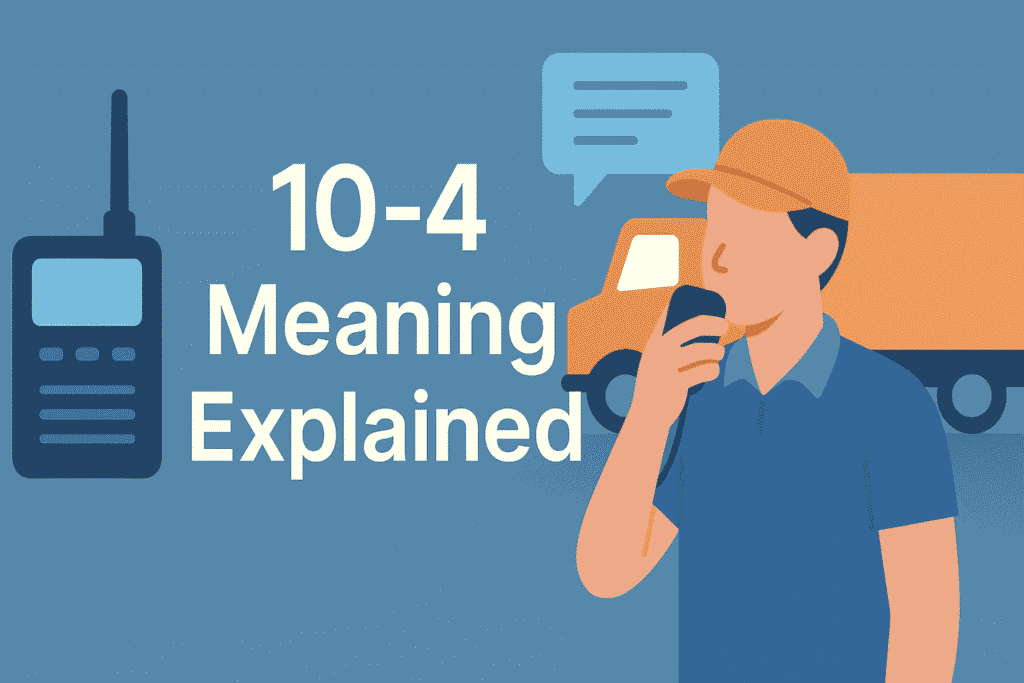
10-4 Meaning: What Does it Really Mean?
So now that you know 10-4 means “message received,” let’s take a closer look at why that matters.
In radio communication-especially when time is tight and the signal isn’t perfect-there’s no space for long replies or repeated clarifications. Saying “10-4” gets the point across instantly. It’s short, clear, and leaves no doubt that the message was heard and understood.
Think of it as the radio world’s way of saying, “I got you.” Not “yes,” not “maybe,” not “wait, repeat that”-just confirmed. That kind of clarity is essential when you’re coordinating officers in the field, guiding trucks on a highway, or responding to an emergency.
Even though it only takes a second to say, 10-4 carries authority. It tells the other person, “I’m on the same page. Let’s keep moving.” It’s that level of certainty that made it stick-not just in professional circles but in everyday conversation too.
You’ll hear people say it while texting, joking with friends, or confirming plans. Because even outside of radios and sirens, 10-4 just works. It’s clean. It’s confident. And it still sounds pretty cool.
The Origin of 10-4: How It All Began
Long before 10-4 became trucker slang or pop culture shorthand, it was born out of a very real problem: bad radio signals. Back in the 1930s, when police departments first started using two-way radios, the technology was far from perfect. The first few words of every transmission were often cut off, leaving officers with half a message and a lot of guessing.
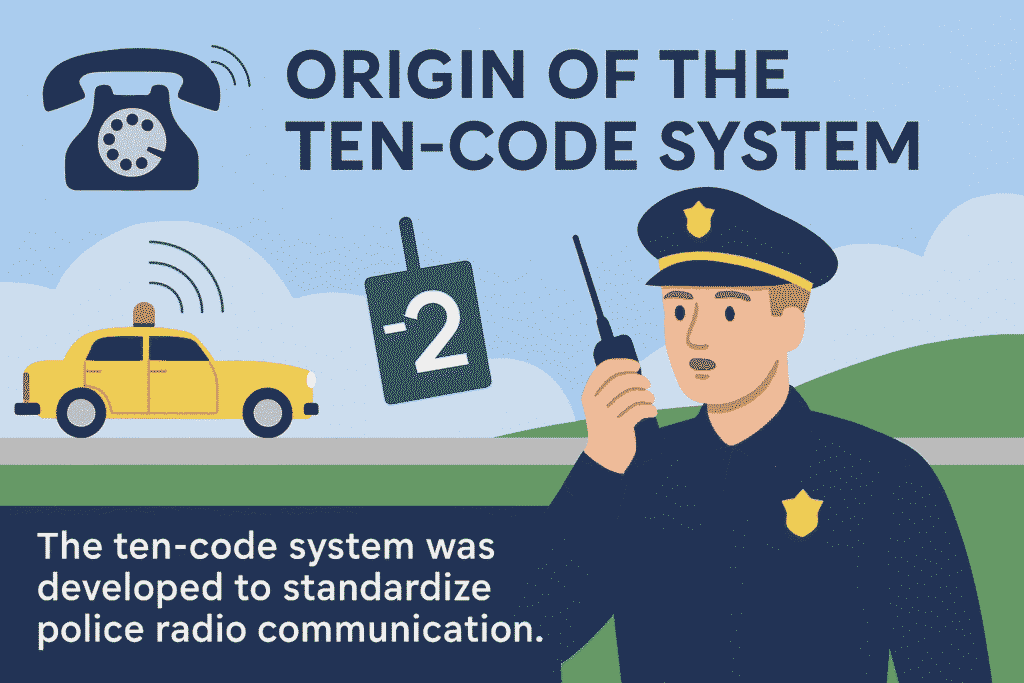
To fix this, the Illinois State Police introduced something new in 1937: a system of short, numbered codes that could cut through the static. It was designed by Charles Hopper, the communications director at the time. Each code started with “10” to give the radio a moment to fully activate before delivering the real message. That’s how “10-4” was born- just two numbers that meant “Acknowledged. I heard you.”
By the 1940s, the system was picked up and standardized by the Association of Public-Safety Communications Officials, or APCO. It quickly spread across departments all over the U.S., giving officers a faster, cleaner way to communicate. And 10-4? It became the most common code of them all-used every day, thousands of times, because every good conversation starts with knowing you’ve been heard.
Breaking Down Ten-Codes: The System Behind 10-4
Once 10-4 became a standard, it didn’t stand alone. It was just one part of a bigger system called the ten-code system-a set of short, numbered phrases that helped people communicate clearly over radio.
Each ten-code started with “10” followed by another number. So instead of saying, “Can you repeat that?”, someone would just say 10-9. Instead of asking for a location, they’d say 10-20. This kept conversations fast, clean, and easy to follow-even when the signal was weak or the situation was tense.
The real genius of ten-codes wasn’t just their speed. It was their flexibility. A dispatcher could send out quick messages to multiple units without repeating themselves. An officer could answer with one number instead of a sentence. And over time, these codes became second nature to anyone working with radios-from police and firefighters to truckers and emergency responders.
While there are dozens of ten-codes out there, 10-4 always stood at the center. It’s the code that started and ended conversations. The one used most often. The one that stuck-even as others began to fade.
Who Uses 10-4 Today?
Although it began as police code, 10-4 didn’t stay locked inside squad cars and dispatch rooms. Over time, it spread-first to truckers, then to emergency responders, and eventually into everyday speech.
Law Enforcement: Where It All Started
Police departments across the U.S. still use 10-4 to acknowledge instructions or updates from dispatch. It’s quick, consistent, and built into their workflow. Even as some agencies shift to plain-language communication, 10-4 remains in regular use because it’s efficient and easy to understand in high-stress situations.
Truckers and the CB Radio Boom
In the 1970s, CB radio exploded in popularity, and truckers adopted the ten-code system as their own. 10-4 became more than a code-it turned into a cultural badge. “10-4, good buddy” wasn’t just a reply. It was a nod of camaraderie between drivers. You still hear it today among long-haul truckers trading info about road conditions, speed traps, and weather.
Firefighters, EMTs, and Other Responders
Beyond police and truckers, other emergency services picked up the code. Fire departments, EMTs, search-and-rescue teams-many still use 10-4 in daily communication. Some departments have shifted to plain speak, but where radios are still in play, 10-4 continues to do its job.
Pop Culture and Casual Talk
10-4 isn’t just for uniforms and radios anymore. You’ll hear it in movies, video games, music, memes, and even group chats. People use it as a confident, shorthand way of saying “Got it” or “Understood.” And while they may not know the history, the meaning carries all the same.
10-4 vs. Other Affirmation Codes
10-4 is often lumped together with phrases like “Roger that,” “Copy that,” or “Affirmative.” And while they all confirm that a message was received, each has a different tone, purpose, and place in the world of communication.
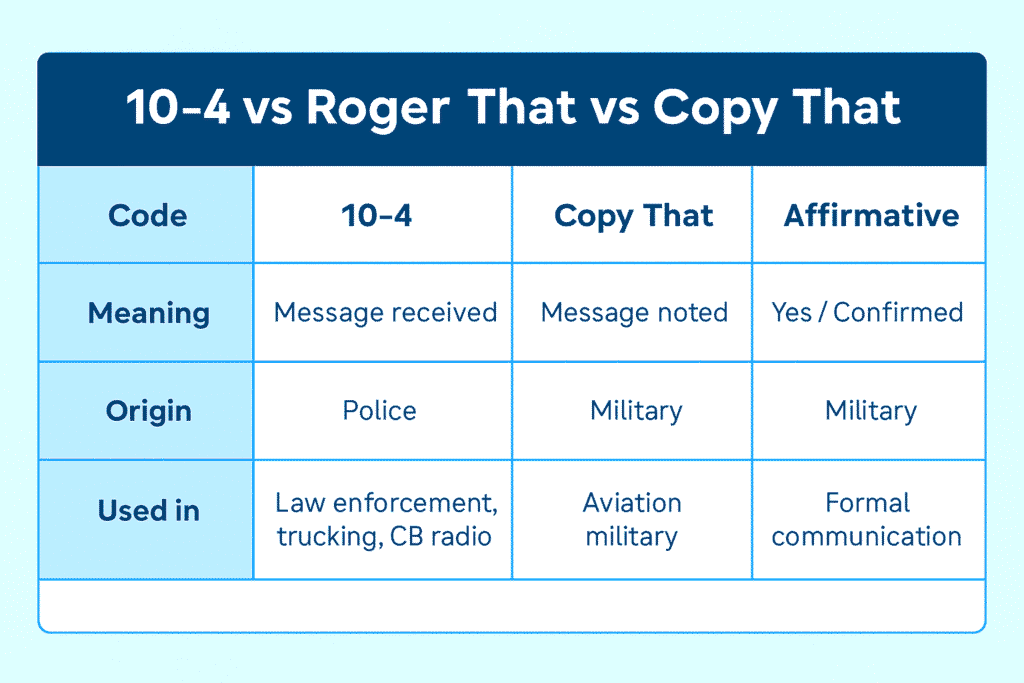
10-4 vs. Roger That
“Roger that” comes from military and aviation communication. It dates back to the early phonetic alphabet, where “Roger” stood for the letter R-short for “Received.” Saying “Roger that” means the message was heard and understood, but it’s not part of the ten-code system. Unlike 10-4, it’s more common in military, aviation, and tactical contexts than police or trucking comms.
10-4 vs. Copy That
“Copy that” is another way to confirm a message, used often in military or operational settings. It suggests that the speaker not only heard the message but has mentally or literally noted it. It carries a slightly more formal or technical feel than 10-4, and it’s not typically used in CB or police radio conversations.
10-4 vs. Affirmative
“Affirmative” simply means “yes.” It’s often used to confirm an action, not just a message. That makes it different from 10-4, which doesn’t express agreement-it only signals that the message was received. Saying “affirmative” commits to something. Saying “10-4” just confirms you heard it.
Why This Matters
These phrases aren’t interchangeable. Each one fits a specific protocol, setting, and tone. 10-4 belongs to a structured radio code system built for fast acknowledgment. It’s clean, reliable, and backed by decades of use. That’s why it has outlasted so many others-and why it still makes sense to use it today.
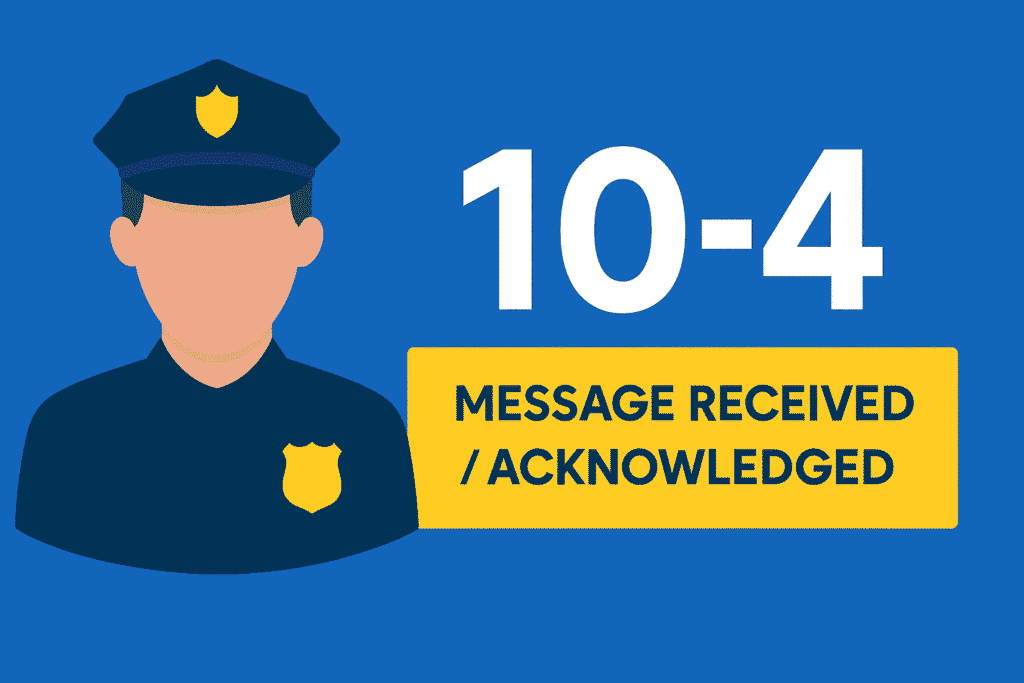
Variations Across Regions and Departments
While 10-4 has a stable, nearly universal meaning, the rest of the ten-code system? Not so much.
That’s because ten-codes were never globally standardized. After the original list was introduced in the 1930s and later formalized by APCO, departments across the U.S. started customizing the codes to fit their own needs. Over time, this led to a strange reality-the same ten-code can mean completely different things depending on where you are.
Take 10-13 for example. In New York, it’s a serious emergency code that means an officer needs assistance. In other states, it simply refers to weather conditions. Some agencies use 10-90 for a crime in progress. Others use it for an alarm call. And 10-99? In one place it signals a warrant; in another, it could mean a jailbreak.
This patchwork of meanings became a real issue during multi-agency responses, especially in large-scale emergencies where police, fire, and federal teams all had to work together. When every group is speaking a slightly different code language, even a simple confirmation can lead to confusion.
That’s one of the reasons many agencies have moved away from ten-codes in recent years. But even with these inconsistencies, 10-4 has stayed the same. It’s the one code that nearly everyone still understands, no matter where you are or what department you’re in.
Why Some Agencies Stopped Using Ten-Codes
As useful as ten-codes were in the early days of radio, they eventually ran into a problem no code system could fix: miscommunication during critical moments.
During major disasters-especially the 9/11 attacks-first responders from different agencies had trouble understanding each other. Firefighters from one city used ten-codes differently than police from another. Ambulance crews couldn’t decode what a state trooper meant. In situations where every second mattered, conflicting codes slowed everything down.
In the aftermath, federal agencies like FEMA and the Department of Homeland Security pushed for a major shift: drop the codes and start using plain language. Say “I need help,” not “10-33.” Say “I’m on scene,” not “10-23.” This move was designed to reduce confusion in high-stakes situations where multiple teams had to work together.
Many departments followed this advice, switching to standard spoken English for all radio communication. But here’s what’s interesting-10-4 didn’t disappear. Unlike other ten-codes, it was already widely understood, even outside professional radio circles. So while agencies dropped dozens of other codes, 10-4 stayed put.
It survived not just because of tradition, but because it still worked-short, clear, and recognized by almost everyone on and off the radio.
Examples of 10-4 in Real-World Use
We’ve covered what 10-4 means, where it came from, and who uses it. But sometimes the best way to understand a phrase is to see it in action. So let’s break down a few real-world scenarios where 10-4 fits naturally into the conversation.
Police Dispatch Example
Dispatcher: “Unit 14, respond to a noise complaint on Oak and 9th.”
Officer: “10-4. En route.”
Here, 10-4 is used to confirm that the officer heard and understood the instruction. No extra words, no guesswork-just clear communication.
Trucker CB Example
Driver A: “Brake check up ahead. Watch your speed near mile marker 62.”
Driver B: “10-4. Thanks for the heads-up.”
In this case, 10-4 serves as both a confirmation and a polite response, showing respect between drivers.
Fire Department Scenario
Dispatch: “Engine 7, backup is five minutes out. Maintain position.”
Firefighter: “10-4. Holding.”
Once again, 10-4 helps move things forward without slowing the moment down.
Casual Conversation
Friend: “Don’t forget to grab coffee on your way.”
You: “10-4.”
Even outside official channels, 10-4 adds a touch of clarity-and a little personality-to everyday replies.
These examples show how flexible the phrase really is. Whether it’s coming through a radio speaker, down a highway, or just through your phone, 10-4 delivers the same message every time: “Got it.”
Frequently Asked Questions
Not every question about 10-4 needs a full breakdown. Sometimes you just want a quick answer. Here are some of the most common questions people ask – and straight-to-the-point responses that clear up any confusion.
What does 10-4 mean in police code?
In police communication, 10-4 means “Acknowledged” or “Message received.” It tells the dispatcher or another officer that the message was heard and understood.
Why do truckers say 10-4?
Truckers use 10-4 as part of CB (citizen band) radio slang. It’s a quick, respectful way to confirm information like road hazards, weather updates, or convoy instructions.
Is 10-4 still used today?
Yes. 10-4 is still widely used by law enforcement, emergency responders, and truck drivers. It also lives on in casual conversation and pop culture.
What’s the difference between 10-4 and Roger That?
10-4 is a numeric code from the ten-code system.
Roger That comes from military radio language and simply means “Received.” Both confirm a message, but they come from different systems.
Where did 10-4 originate?
10-4 originated in 1937 with the Illinois State Police. It was part of the first ten-code system created to improve radio clarity in law enforcement.
What does “10-4 good buddy” mean?
It’s a classic phrase from CB radio culture. “10-4” means “Got it,” and “good buddy” is a friendly way for truckers to refer to each other.
Cultural Impact and Legacy of 10-4
What started as a technical radio code didn’t stay behind the mic. 10-4 made its way from tactical lingo to cultural language, gaining momentum with truckers and eventually landing in music, movies, memes, and casual speech.
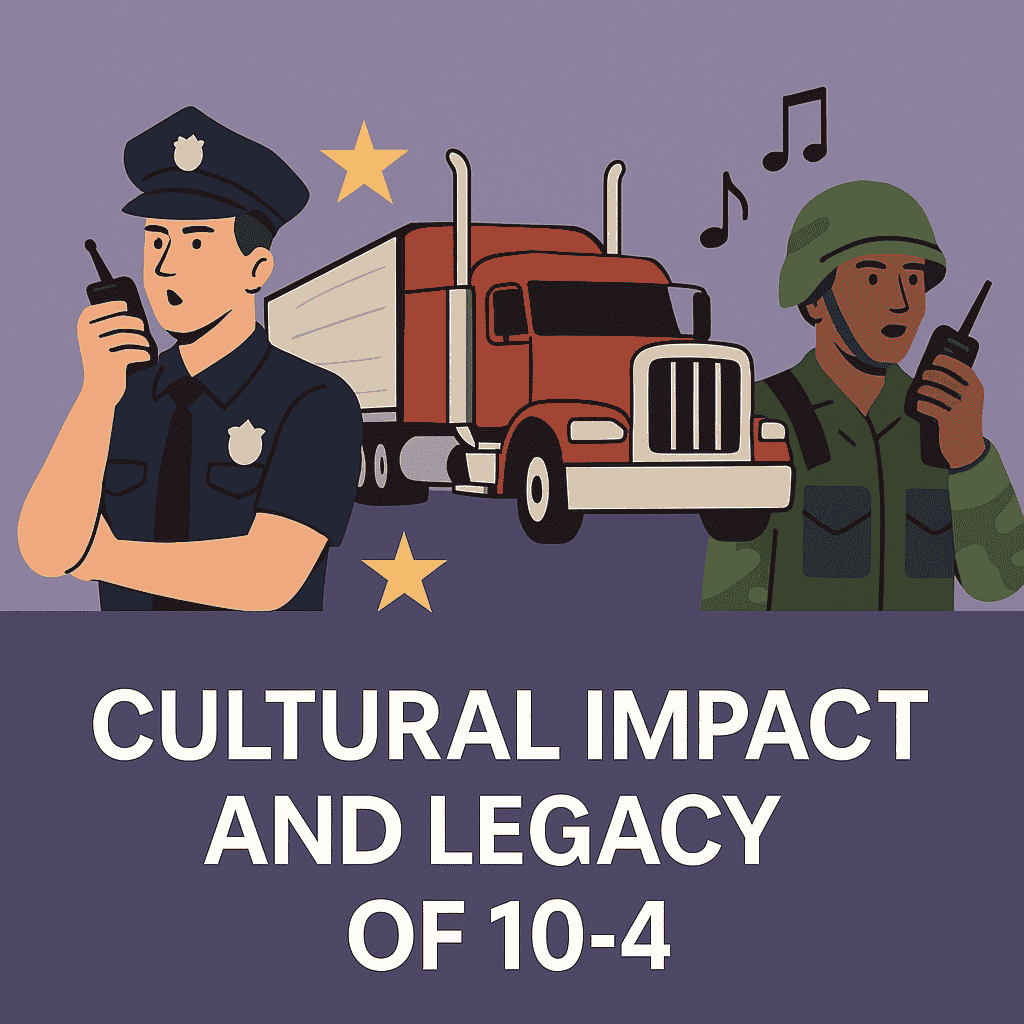
Its breakout moment came in the 1970s, during the peak of CB radio culture. Songs like “Convoy” by C.W. McCall turned 10-4 into a nationwide catchphrase. Movies like Smokey and the Bandit used it as part of trucker dialogue, reinforcing its identity as a friendly, cool, in-the-know phrase. Police shows and highway patrol dramas kept the term alive on-screen, where it often became the fastest line in every radio exchange.
Decades later, 10-4 still pops up-not just in nostalgia, but in the daily digital stream. You’ll find it in TikTok captions, short-form comedy skits, Instagram comments, and internet memes. It’s used both seriously and ironically, depending on the tone, but the core meaning remains: message received.
Alongside it, other codes have quietly followed. Slang like “10-20” (for location), “breaker” (to request to speak on a channel), and even non-code phrases like “copy that” all reflect the same urge for crisp, coded communication. But 10-4 remains the anchor. It’s the one phrase that survived the leap from radios to real life and never lost its meaning.
Two Digits That Still Speak Volumes
In just two numbers, 10-4 manages to do what entire sentences often can’t-deliver clarity, confidence, and confirmation. It was built for speed and precision during a time when communication needed to be sharper than ever. And while radio systems, protocols, and even language have evolved, 10-4 hasn’t gone anywhere.
It started in law enforcement. It spread to truckers. It found its way into firehouses, emergency crews, and eventually pop culture. Today, it’s more than just a radio code-it’s a phrase people still use when they want to be clear, quick, and understood.
If you’ve ever wondered what 10-4 really means, now you know. And the next time someone says it-on the road, in a movie, or in a text-you’ll hear more than just an answer. You’ll hear a legacy that’s still going strong.
